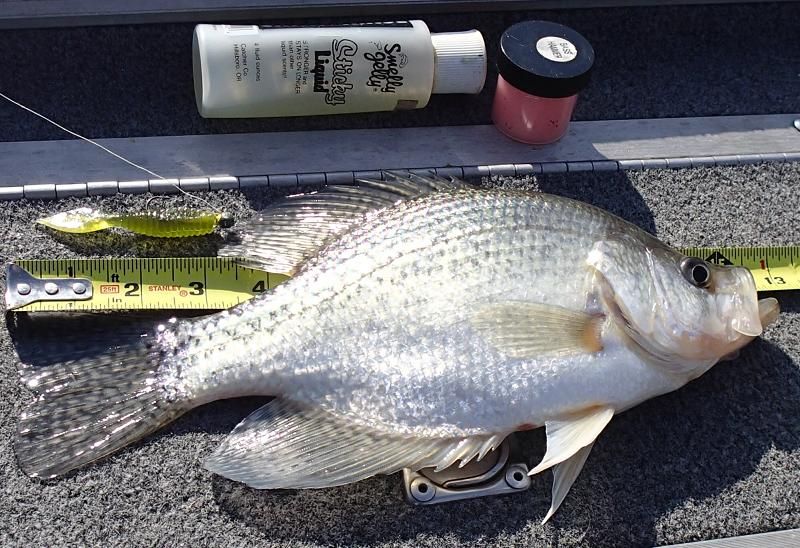Here is a good article about using scents for fishing, although they're talking about commercial products, and the articles linked at the bottom of the page are also good:
http://www.bassresou...ttractants.html
I've noticed while ice fishing that scents and/or scented lures sometimes make a difference when fish are not in a feeding mood. I've used this observation to extend it to my open water fishing adventures when the bite is tough. When they're biting well, I don't need them. I've pretty much tried most of them and they all work pretty well, but the best that I've observed through the ice is the Berkeley "Gulp Alive" product. I purchased their lures that come in tubs soaked with it, and also dump some of my other soft plastics in there at times. The only negative thing about that is that sometimes the colors of some soft plastics run and change the color of the formula. BTW, that stuff smells nasty...but is almost impossible to avoid getting it on your hands and getting a whiff when using it. Gulp Alive is also sold separately from their plastics in a spray type container.
I've also used, and still do use, Fish Formula, Bang, and another one called Smelly Jelly. I have the latter in both paste and liquid form, and prefer the paste because it seems to last longer.
In the pic below, notice the two Smelly Jelly containers. My friend, Gene Mueller, the retired Outdoors Writer for the Washington Times newspaper and retired blogger turned me on to the stuff. The pink container is the pasty product, while the other is liquid.

It does work in my opinion, and if anything, at the very least does bring an added measure of confidence. On that day, my buddy Howard and I tore up the crappie, almost all of them that size too. I caught two to his one early on before he started raiding my supply.
OK, do you need to buy commercial products and achieve the same result? No, you can make your own. Other than the Gulp secret formula, most of the others have a common oil, or similar oil, usually some sort of fish oil that you can buy at a grocery store...even sardine oil will work. Additives that provide additional attraction are anise, garlic or salt. You can thicken your mix into a paste by adding glycerin or even Jello.
People have tried many things but the most important thing is to check with your local regs on the legality of what you make your blend with. I think that in most states you'd be OK if you used strictly organic stuff in your mix.
That said, by the time you've spent the money on your materials and time, you might actually save money by purchasing a commercial legal product.
There is another twist, whether mixing your own scent or purchasing some, if you pour your own soft plastic baits then you can mix the scent and other attractants into your soft plastic prior to putting it into the mold. Just remember that the more stuff you add to the plastic, whether it's oil, salt, or garlic, the less durable your lure might be. Gulp products have some sort of hardener added to their soft plastics to make them tough.
An example of a weaker soft plastic, but effective, and expensive, is the Yamamoto Senko. They are full of salt, inside and out, enough to cause them to sink much much faster than other soft plastic lures. Their action is fantastic, and they really catch fish. Almost every lure manufacturer produces a knock off and most are effective as well. Anyway, my point here is that even though they're very good lures, they tear easily. I use a battery powered braided line cutter as a torch to repair my used torn soft plastics which comes in handy while fishing and you're down to the last one of your favorite lure. At home, you can do this with a soldering iron.
Finally, back to Gulp. How well does it work? Several years ago I was drift fishing for croaker with a buddy of mine out of his boat on the Chesapeake Bay, using bloodworms for bait. When you find a school, you're pretty much guaranteed to catch them with bloodworms. But, the proboscis creeps my out, and I don't like the bloody baits all over my clothes and stuff...they're just plain messy. So, I pulled out a Gulp 4" twister tail, stuck it on a 1/4 oz. jighead and started jigging in an attempt to catch sea trout. I kept getting bites but couldn't hook the fish, like they were too small. I figured that the croaker might be doing this, so I cut some strips of Gulp plastic off my twister tail and hooked them on to my croaker spreader rig and dropped it overboard. As soon as it hit the bottom, I had a bite, set the hook and reeled two croakers to the boat. By the end of the afternoon, I was catching almost as many croaker as my buddy. From that point on, I think he was up on me by six fish, but I caught 60 of them.
Why is this a big deal, at least to me? I've never caught a croaker before on any other soft plastic lure/scent combo prior to that day.











